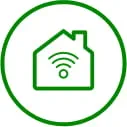In the not-so-distant past, the very idea of streaming high-definition videos or playing graphics-intensive online games seemed like nothing more than a distant dream that could never come true. But over the years, the evolution of internet speeds radically transformed the digital landscape. From the agonizingly slow days of dial-up connections to the lightning-fast speeds of fiber optics, the journey has been nothing short of revolutionary.
The age of dial-up
The internet's humble beginnings were marked by the screeching tones of dial-up modems connecting households to the World Wide Web. In the 1990s, the annoyingly iconic sound of a modem “handshake” was the announcement of frustratingly sluggish speeds. Dial-up connections were limited by the capabilities of telephone lines, with speeds crawling at a mere 56 Kbps (kilobits per second). Downloading a single image could take minutes, and streaming audio was often interrupted by buffering pauses.
However, as the demand for faster internet grew, so did the need for more efficient technology. Dial-up, with its severe limitations and constant connection disruptions, paved the way for broadband to emerge as the next major step in the evolution of internet speed.
The rise of broadband
Broadband, with its higher data transfer rates, offered a significant improvement over dial-up. Digital Subscriber Line (DSL) and cable broadband became popular choices, providing speeds ranging from 128 Kbps to several megabits per second (Mbps). The term "broadband" itself signified a broader bandwidth, enabling users to download files, browse websites and engage in online activities more seamlessly.
DSL utilized existing telephone lines, offering faster speeds than dial-up without the need for a separate line. Cable broadband, on the other hand, piggybacked on cable television infrastructure, providing faster and more reliable internet access.
The broadband era marked a transformative period for the internet, making it more accessible and user-friendly. However, as the demand for bandwidth-intensive applications like video streaming and online gaming increased, broadband faced its own set of limitations.
The advent of high-speed internet
Recognizing the need for even faster internet speeds, the early 2000s saw the emergence of high-speed internet technologies like Fiber to the Home (FTTH) and Digital Cable Internet. These advancements represented a leap forward in the evolution of internet speeds.
Fiber optics, in particular, emerged as a real game-changer. Instead of relying on electrical signals over copper wires, fiber optic cables used pulses of light to transmit data. This resulted in significantly higher bandwidths and faster speeds, with early fiber optic connections offering speeds in the range of tens or hundreds of megabits per second.
The fiber optic revolution
Fiber optics laid the foundation for the broadband revolution we experience today. As demand for faster and more reliable internet continued to grow, telecommunication companies invested heavily in deploying fiber optic networks. The speed and efficiency of fiber optics were unparalleled, providing gigabit speeds (1,000 Mbps) and beyond.
Fiber-to-the-Home (FTTH) deployments brought the benefits of fiber optics directly to households. With FTTH, internet speeds were no longer constrained by the limitations of copper infrastructure, resulting in a quantum leap in performance. Streaming high-definition videos, engaging in real-time online gaming and connecting multiple devices simultaneously is the new norm.
The evolution of internet speeds from dial-up to fiber optics is a testament to human innovation and the relentless pursuit of faster, more efficient connectivity. As we stand on the cusp of new technological frontiers, the internet's transformative power continues to reshape our world. From the humble beginnings of dial-up to the lightning-fast speeds of fiber optics, the internet speed revolution has come a long way, and the journey is far from over. As we navigate the future of connectivity, one thing is certain—the need for speed will only continue to drive the evolution of the internet.






